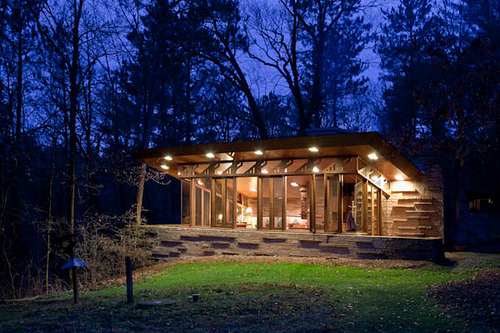 A month before I met Mrs. T, I spent a night in Frank Lloyd Wright’s Seth Peterson Cottage, which is located on a bluff overlooking a lake two miles from the Wisconsin Dells and is available for short-term rentals. Not long afterward I wrote a piece about the experience for The Wall Street Journal. No sooner did I discover that my spouse-to-be was equally passionate about Wright’s architecture than I resolved to bring her to the cottage at the earliest opportunity. It wasn’t easy—you have to book your stay a year in advance—but yesterday we finally made it.
A month before I met Mrs. T, I spent a night in Frank Lloyd Wright’s Seth Peterson Cottage, which is located on a bluff overlooking a lake two miles from the Wisconsin Dells and is available for short-term rentals. Not long afterward I wrote a piece about the experience for The Wall Street Journal. No sooner did I discover that my spouse-to-be was equally passionate about Wright’s architecture than I resolved to bring her to the cottage at the earliest opportunity. It wasn’t easy—you have to book your stay a year in advance—but yesterday we finally made it.
I have no words to describe the feeling of tranquility that washed over us as we walked through the door of the Peterson Cottage, knowing that it was to be all ours for the next two days. Entering the cottage is like putting on a piece of exquisitely well-tailored clothing: you feel at one with the house and its surroundings, so much so that you can scarcely tell the difference between indoors and outdoors. To be sure, you wouldn’t want to stay there for more than an hour or two with anyone other than the closest of companions. The two-room cottage is small—880 square feet—and the only interior door is the one that leads to the bathroom. Yet you never feel cramped, precisely because Wright took such great pains to meld the house with its site.
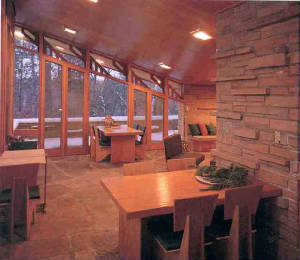 Not being a student or critic of architecture, I can’t say anything more informative about the design of the cottage than what Paul Goldberger wrote about it in 1994:
Not being a student or critic of architecture, I can’t say anything more informative about the design of the cottage than what Paul Goldberger wrote about it in 1994:
The house is Frank Lloyd Wright boiled down to his essence: Powerful geometric form; low, contained spaces played off against exuberantly high ones; a sense of natural materials put together into a composition that at once seems to hug the earth and blast off from it. From the outside, it is at once serene and energetic. A solid section of stone, barely bigger than a chimney, anchors the center. The low horizontal of the bedroom ceiling comes off from one side, and the high, raked roof of the living-dining room bursts out from the other. The solids and the voids, the lows and the highs, the horizontals and the verticals, are in harmony.
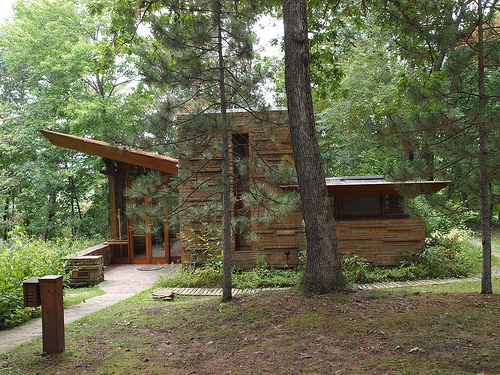 The last word of that passage put me in mind of the exquisite lines from The Merchant of Venice that Ralph Vaughan Williams set in his Serenade to Music: Here will we sit and let the sounds of music/Creep in our ears: soft stillness and the night/Become the touches of sweet harmony. As my beloved spouse and I sat in the soft stillness of the Wisconsin night, we felt the sweet harmony of the Peterson Cottage, in which the built and natural worlds resonate in perfect concord.
The last word of that passage put me in mind of the exquisite lines from The Merchant of Venice that Ralph Vaughan Williams set in his Serenade to Music: Here will we sit and let the sounds of music/Creep in our ears: soft stillness and the night/Become the touches of sweet harmony. As my beloved spouse and I sat in the soft stillness of the Wisconsin night, we felt the sweet harmony of the Peterson Cottage, in which the built and natural worlds resonate in perfect concord.
Careworn and road-weary though we both are, I doubt that Mrs. T and I have ever been much happier than we are today.
* * *
A 1938 British Pathé newsreel of Sir Henry Wood recording Ralph Vaughan Williams’Serenade to Music with the musicians who gave its premiere a few days earlier. Vaughan Williams was present at the session:

 Yes, I wrote both the script of the play and the
Yes, I wrote both the script of the play and the  What makes all this so important is that Dennis’ job is to get up in front of an audience and embody Armstrong. I did a certain amount of acting in my youth, and though I wasn’t particularly good at it, I do know what it feels like to play a part. It’s nothing like putting on a mask: you have to meld with the character you’re playing, using elements of your own experience to bring his personality to life.
What makes all this so important is that Dennis’ job is to get up in front of an audience and embody Armstrong. I did a certain amount of acting in my youth, and though I wasn’t particularly good at it, I do know what it feels like to play a part. It’s nothing like putting on a mask: you have to meld with the character you’re playing, using elements of your own experience to bring his personality to life.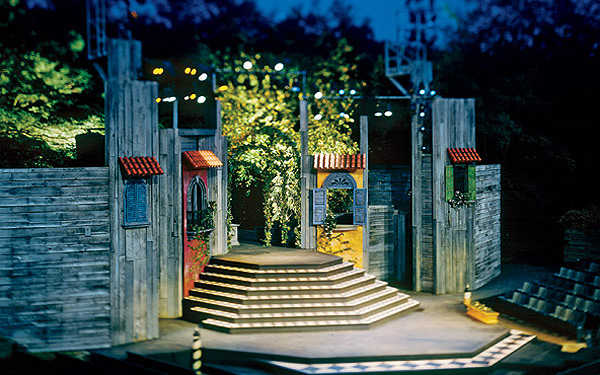 Mrs. T and I continue to live out of our suitcases. On Friday we made it to Spring Green, Wisconsin, after spending three unscheduled days in Smalltown, U.S.A., with my mother, who is recovering from her third operation in as many months. Her prospects, unlikely as it may sound, are extremely good.
Mrs. T and I continue to live out of our suitcases. On Friday we made it to Spring Green, Wisconsin, after spending three unscheduled days in Smalltown, U.S.A., with my mother, who is recovering from her third operation in as many months. Her prospects, unlikely as it may sound, are extremely good.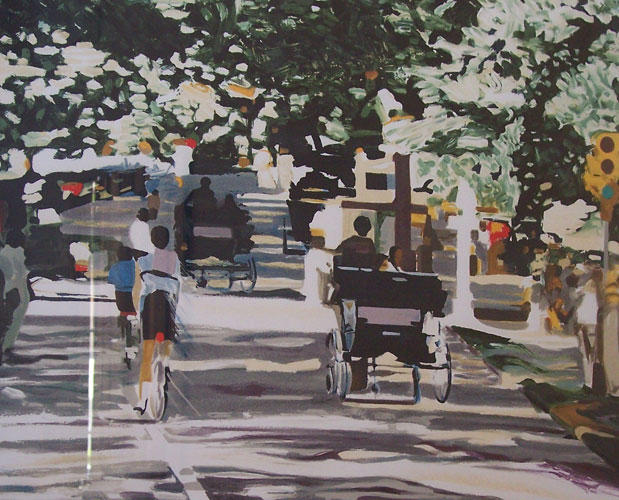 Today is what theater people call a “dark day,” meaning that we don’t have any shows to see. Mrs. T has the day off, but I have to write, so I got up early, ate breakfast, and knocked out Friday’s Wall Street Journal drama column, after which I started working on a Commentary essay about Tony Bennett, who is the subject of a
Today is what theater people call a “dark day,” meaning that we don’t have any shows to see. Mrs. T has the day off, but I have to write, so I got up early, ate breakfast, and knocked out Friday’s Wall Street Journal drama column, after which I started working on a Commentary essay about Tony Bennett, who is the subject of a